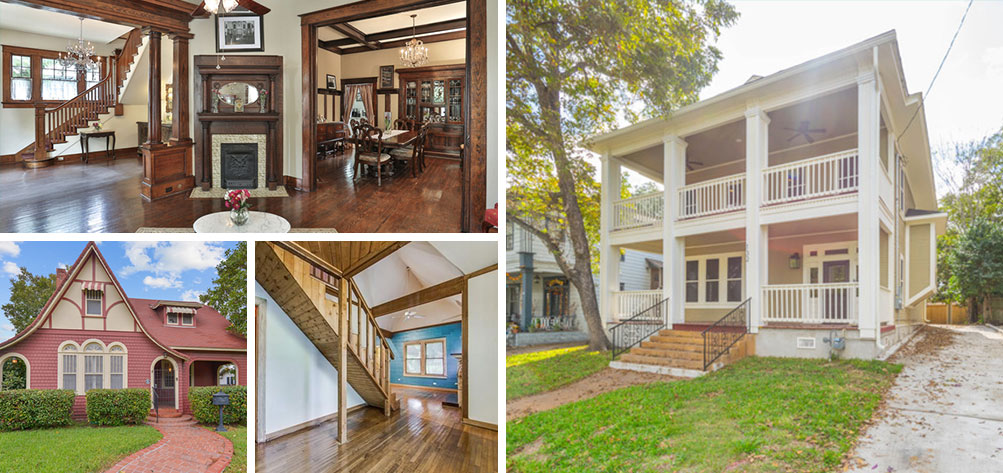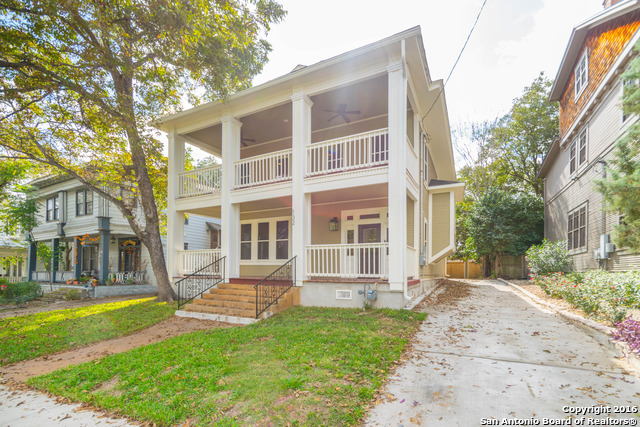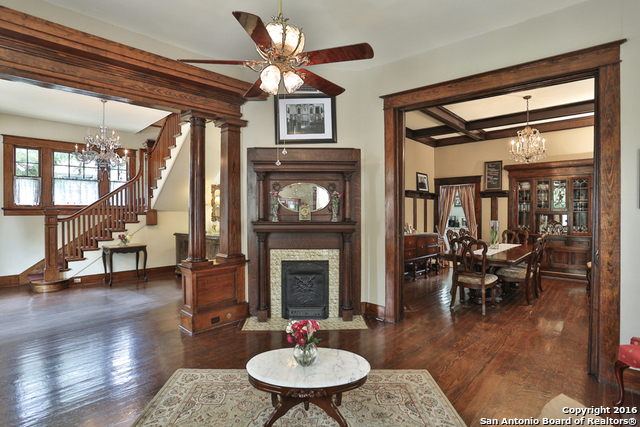Whether you’re a new San Antonio resident or you’ve lived in the Alamo city for years, one thing is obvious: San Antonio is pulsing with Texas history and culture. In fact, as many of us learned in our middle school Texas history classes, early records can trace the first residents back to Spanish missionaries in the late 17th century. Knowing this, it makes sense that San Antonio currently boasts some pretty historic neighborhoods; 27 to be exact. These designated historic districts, range in size from a few blocks long to seven miles wide and have become ultra popular since the incline in urban appeal San Antonio has been seeing. But, while these historic districts appeal to homebuyers for so many reasons, you don't know what you don't know. So, let us help demystify your historic house hunt.
132 E. Magnolia Ave Monte Vista
Let’s start with the basics. What is considered a historic home, neighborhood, or district, and why would you want to own a home in one? Historic districts exist to preserve the integrity and cultural significance a specific neighborhood may bring to the city, state, or country. Famous residents, signature architectural styles, or important historical events can make a neighborhood worthy of such historical designation. Once the historical value of a neighborhood is recognized, it is usually overseen by either the national or local government.
1. Who oversees my district?
If a home or neighborhood is of major historical significance, the National Register of Historic Places might name the area a nationally important district! San Antonio currently claims 19 National Register Historic Districts, including the coveted King William and Monte Vista neighborhoods. If you own a home in one of these neighborhoods, you may qualify for perks such as tax breaks and government grants to maintain or restore your home.
The
The rules and regulations concerning national historic districts are a bit more relaxed than local, simply because more city planning happens at the local level [Note: many historic districts have both national and local designation]. For a list of all the historic districts in San Antonio, click here!
2. They foster intentional community
One of the most surprising and exciting things about owning a home in a historic neighborhood is the sense of community it fosters. Owners of historically significant homes or neighborhoods choose to live in their area because they truly care...they care about the city of San Antonio, they are passionate about their neighborhood, and they love their home. These shared interests tend to bring people together, fostering a truly unique sense of neighborhood pride and awareness. While charming architecture and historic details are welcoming, it’s the lifestyle of the neighborhood that tends to sell buyers on living in a historic district.
514 N Pine Dignowity Hill
3. You may enjoy tax benefits and incentives
So what if living in a historic home also meant receiving tax benefits? For those who desire to live in a historic neighborhood, the financial payoff is certainly an added perk! For example, if you’re interested in preserving and/or restoring a piece of San Antonio history, you may be able to receive tax credits or lower interest loans. If your home is nationally recognized, you may also be eligible for government grants. In San Antonio, a 20% tax exemption is offered to residents in new historic districts for up to 10 years (and can be extended to 15 years). But while all that is exciting, it is important to remember that property taxes aren’t affected at all by historic designation.
503 E Myrtle Tobin Hill
4. They can make a positive impact on the community.
If you’ve been looking at buying a home in a historic district (especially a new historic district), you may have heard the buzzword “gentrification” and all the varying opinions concerning its level of harm or help in the local community. In San Antonio, the gentrification process gives residents the opportunity to make a positive impact! Since historic districts are more often in the heart of the city, a sudden influx of residents interested in gentrifying the area can drive up property value, which also increases tax revenue. This increases the money put back into the neighborhood’s city services, helping improve local benefits like educational programs and subsidized housing. Also, as a sometimes unintended bonus, living in a historic neighborhood can have a positive effect on the environment: utilizing historic districts helps curb urban sprawl and recycles pre-existing resources.
324 Adams King William
5. You may face rehabilitation rules and codes
While owning a home designated as “historic” is exciting, it can certainly come with its fair share of red tape. Because the goal of historic neighborhoods is “preserving the character” of the area, most historic districts are governed by a set of rules and regulations regarding the appearance of its homes. These regulations almost never affect the interior. However, if you want to make updates to the exterior, you will have to get them approved by local authorities. On the other hand, if you’re interested in restoring the exterior of your home, you may receive tax exemptions, loans, or grants to do so!
173 Hermine Blvd. Olmos Park Terrace
6. Upkeep might be more costly
When purchasing a historic home, you have to be aware of the long-term upkeep costs. Many older homes aren’t quite as energy efficient as their newer counterparts. Depending on the home you’re purchasing, it might cost more to keep the temperature stable or run an impressive show of Christmas lights. Repair might also include more costly repair materials specific to the time the home was built. That being said, not every historic home costs extra to keep up! The specific design and construction of your home will be unique. Be sure to ask your REALTOR about specific details regarding utilities and upkeep cost!
7. A historic home is a great investment
Maybe at this point you’re wondering if purchasing a historic home is worth it. If it costs you a fortune to heat in the winter and repair after a storm, what’s the point? Well, this next point may change everything. The historical designation of a neighborhood has actually proven to have an extremely positive effect on property values, increasing between 5-20%! These neighborhoods also experience a much lower owner-to-owner turnover rate, indicating buyers are happy with their homes as long-term investments. These properties appreciate at a greater rate than their counterparts and are less susceptible to interest rate changes.

173 Hermine Blvd Olmos Park Terrace
8. There are experts and professionals available to help
Perhaps the most important rule of understanding historic districts is, in fact, admitting that you might not know everything. Experts in historic real estate will be essential during the process of touring, buying, and rehabilitating a piece of San Antonio history. Before beginning any serious buying process, we recommend creating a list of informational and professional resources that will be helpful during the process. First of all, we advise finding a REALTOR who is knowledgeable concerning historic districts and the surrounding neighborhoods. Additionally, an independent home inspector will be helpful when assessing the current state of your potential historic home. You’ll want this inspector to be experienced in historic district’s codes and regulations! If you do decide to purchase a historic home in need of rehabilitation, it might be helpful to use a consulting firm that specializes in building conservation. These are just a few professional resources you may consider before making the leap to a historic home!
If you’re looking to live in a historic home, San Antonio is one of the best places to do so! The unique blend of Spanish, Texan, and Mexican culture makes San Antonio’s cultural influence especially unique. Perhaps this is why San Antonio's historic homes are so highly valued and carefully protected, and why so many San Antonians (and transplants!) are flocking to these areas in the masses.











